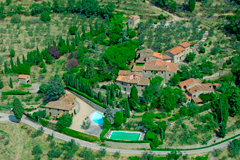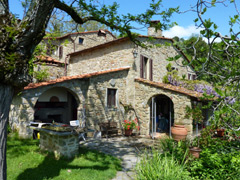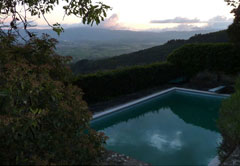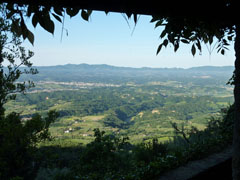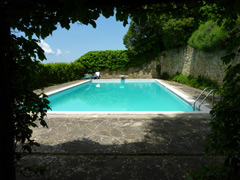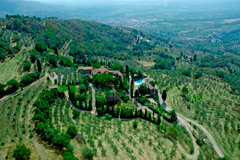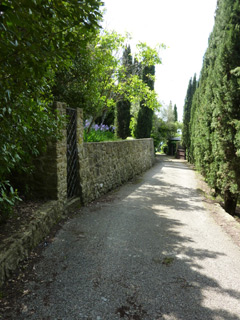Loro Ciuffenna & Oliveto
Oliveto is one of many hill villages in the community of Loro Ciuffenna, a town founded by the Etruscans straddling a deep gorge of the Ciuffenna stream flowing down from the Pratomagno mountains. The name Loro Ciuffenna refers to the stream and the laurel or bay trees that abound there. In Etruscan times the town was reached by a road that linked the city-states of Chiusi, Arezzo and Fiesole, as well as the riverside settlement that became Florence.
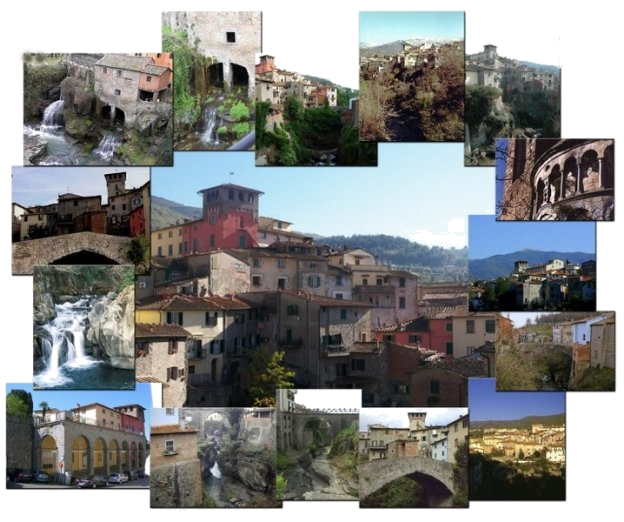
The Romans rebuilt the road as the Via Cassia Vetus, a major military and trade route through the Middle Ages, when traffic mixed merchants with invading armies and pilgrims on their way to Rome. Today the quiet road known as the Via dei Setteponti (after seven bridges, though there are actually many more) hugs the picturesque Pratomagno foothills through a daunting series of curves.
Inhabited in the early Middle Ages by Byzantines and Longobards, Loro Ciuffenna became the domain of the Counts Guidi in the 11th century before coming under the dominion of the Republic of Florence in the 13th century.
Today it’s considered one of “Italy’s most beautiful burgs.” In the center of town are a water-powered grain mill in constant use since the 11th century, and an arching Romanesque bridge over the Ciuffenna gorge. A prime attraction is the nearby Pieve di San Pietro at Gropina. The abbey, built in the 8th century on the ruins of an older church, is a unique example of Romanesque architecture. Roads wind through the hills to quiet hamlets with inviting inns and shops serving local food specialties and wines. Within the community is the hamlet of Borro, charmingly restored by the Ferragamo fashion family, which has a villa and vineyards there.
A Loaf of Bread, a Jug of Wine...
Oliveto overlooks a vast spread of vineyards through the Arno Valley and Chianti hills. Beyond the hearty goodness of Chianti Classico and Chianti Colli Aretini, the area is renowned for “Super Tuscans” including Galatrona and Caberlot, regularly ranked among Italy’s finest red wines. Tuscan cooking reaches peaks of goodness in restaurants and trattoria. The epic bistecca alla fiorentina, thick steak from local Chianina beef, is seared to tender perfection over coals of olive wood. Steaks are accompanied by zolfini, tiny white beans grown exclusively in neighboring fields, and doused with extra virgin olive oil, the pride of every farm. Meals begin with antipasti that includes crusts of bread with chicken liver paté and an array of salumi: pork specialties that take in different styles of salami and prized Prosciutto di Pratomagno ham, sliced paper thin. Zolfini beans also figure in the classic vegetable and bread soup known as ribollita. Pasta dishes come in multiple forms and flavors. Locally prized are wide pappardelle ribbons with ragout based on pork or hare or wild boar.
The wooded hillsides are a prime source of mushrooms, led by plump porcini but taking in other intriguing types. Main dishes, beyond beef and pork, include rabbit and poultry, such as free-range Valdarno chicken or duck or goose roasted to succulent goodness in wood-fired ovens. Pecorino, the exemplar of Tuscan cheeses, comes in a multitude of types and styles, ranging from soft and mellow Marzolino to aged versions that may be firm and tangy or hard and zestily sharp.
Florence, Siena, Arezzo and the Heart of Tuscany
From Loro Ciuffenna, Florence can be reached in an hour by car or train. The world center of Renaissance art has innumerable attractions beyond the Uffizi Galleries, Michelangelo’s David and the shops of the Ponte Vecchio.
An hour drive to the southeast is Siena, city of the Palio horserace with a treasure trove of art and architecture in the historic streets and piazzas centered around the monumental Duomo.
Arezzo, 30 kilometers away, is the home of the poet Petrarch and the painter Giorgio Vasari. Born nearby were Michelangelo and Piero della Francesco, whose frescoes in various churches have become the targets of pilgrimages by art lovers.
Loro Ciuffenna lies on the western edge of what it often described as the Heart of Tuscany. Noted attractions within these gorgeous hills include San Gimignano, of the many towers and the famous wine towns of Montalcino and Montepulciano; and the Etruscan center of Chiusi. Within easy reach of Loro Ciuffenna are such noted places as Cortona, Pienza, Panzano in Chianti and Castello di Brolio. Each village in the heartland boasts treasures of art and architecture, inviting hotels and agri-tourist farms, trattorie and osterie specializing in foods that are often unique to the locality.
Fashion Valley
The Arno valley is the home of Prada and other fashion houses and a major supplier of clothing, leather goods, furniture and items of Italian design. Throughout the valley, shops and outlets offer bargains from such houses as Ferragamo, Gucci, D&G, Tod’s and Armani.
